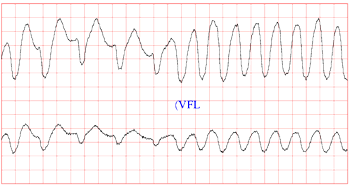ARRHYTHMIA; ANTIARRHYTHMICS
Arrhythmia is a term that is used to describe an abnormal electrical pattern within the heart. The heart is divided into two upper chambers (atria) and two lower chambers (ventricles) [Image 1].
Image 1: Chambers of the Heart
Before the chambers can contract, they must receive an electrical signal, the same way that you must plug in an electrical appliance before the motor will work. The electrical signal is picked up by electrodes on the chest and displayed as a waveform call an Electrocardiogram or ECG (Image 2).
Image 2: The electrical conduction of the heart normally starts in the sinoatrial node in the upper right chamber (right atrium). The conduction wave travels to the left atrium, and downward until both ventricles receive the message.
Normally, the electrical signal takes on a very predictable pattern. The upper chambers send the first electrical signal, followed by a signal from the lower chambers. The electrical signal begins in the right atrium in a special area called the "sinoatrial node". When the electrical pattern of the heart takes on a normal sequence, the sinoatrial node (or sinus node) produces the first wave. This wave is followed by a signal from the lower chambers. This sequence is called a sinus beat (Image 3). When all of the beats are produced by this normal sequence, we call electrical pattern a "normal sinus rhythm" (Image 4). Normal sinus rhythms are regular and beat at a rate of 60-100 times per minute.
Image 3: The normal sequence of one heart beat (sinus beat)
Image 4 Normal heart rhythm (normal sinus rhythm)
For many reasons, different areas of the heart can initiate the electrical message. Beats that start from a location other than the sinus node are called "ectopic beats" (beats that originate outside the normal location) (Image 5). They are easy to recognize because the ECG pattern looks different or comes earlier than expected. An ectopic beat is also called an "arrhythmia". Sometimes, all of the beats begin from another location. This is called an an ectopic rhythm. They can be regular or irregular, and may be fast, slow or at a normal heart rate (Image 6).
Image 5: Example of an occasional ectopic beats (earlier than expected or look different). This would not require treatment.
Image 6: Example of an ectopic rhythm (atrial fibrillation). It is irregular and looks different than a normal sinus pattern. This rhythm is usually well tolerated. We might choose to treat it if it becomes fast or the patient's blood pressure should fall.
Most healthly people have occassional arrhythmias, therefore, they do not indicate a problem. When they happen frequently, they can cause problems with the blood pressure or the strength of the heart's contraction. A heart that is diseased is more likely to have arrhythmias. We only treat arrhythmias if they are affecting the blood pressure, the strength of contraction or carry a high risk for deteriorating into a more serious rhythm.
If we need to treat an arrhythmias, we give an antiarrhythmic. Amiodarone is a drug that is frequently used when we want to start an "antiarrhythmic". An antiarrhythmic suppresses the ectopic (abnormal) rhythm.
Occasionally, the lower chambers can begin firing very quickly, causing a life-threatening rhythm called ventricular tachycardia. The BP will usually drop with this type of rhythm. It can deteriorate to a chaotic and ineffective quivering of the ventricles, called ventricular fibrillation. This is a type of Cardiac Arrest. The treatment for ventricular fibrillation is Defibrillation or "electrical shock" (Image 7)
Image 7: Example of a serious and chaotic rhythm.










